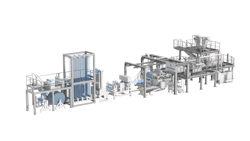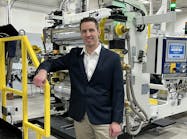Extruder OEMs are expanding their sheet offerings with new models and targeting sustainability efforts with lines that can process bio-based resins and post-consumer PET.
Battenfeld-Cincinnati expands sheet extrusion offerings
Battenfeld-Cincinnati has updated existing extruders to allow them to produce sheet.
The company’s uniEX single-screw extruder series now includes 35mm, 45mm and 60mm models engineered for sheet extrusion; previously, the company touted the extruders for pipe and profile production.
UniEX extruders have a compact design and high throughputs with gentle melt treatment, which makes them ideal for use as coextruders on a sheet line, the company said.
They can produce multilayer sheet, mono-material sheet with a modified covering layer or sheet with a middle layer consisting of regrind, the company said. The models have a small footprint and shorter melt channels than many extruders, which reduces purging times and resin consumption.
Depending on the material, output ranges from 110 to 1,102 pounds per hour. A range of plasticizing units is available, which come with either grooved or smooth feed zones, and can be equipped with a degassing unit, which is required for ABS processing.
Various options are available, including screw extraction to the rear, a gearless drive via a torque motor, and flexible positioning of the control cabinet.
Originally developed for high-tech applications, Battenfeld-Cincinnati’s Multi-Touch XXL roll stacks now are available as part of complete extrusion lines for making high-impact PS boards for refrigerators.
“Due to the high-cost pressure in the white goods area, it is vital for the manufacturers to have a powerful, reliable line with a high performance in terms of sheet quality,” Battenfeld-Cincinnati said.
The Multi-Touch XXL roll stacks, which can operate on high-speed lines, produce ideal cooling conditions and precise thicknesses. These features allow the roll stacks to contribute to the production of high-quality semi-finished products.
In addition to the roll stacks, the lines include three high-speed extruders that provide an output of up to 6,614 pounds per hour. The extruders are capable of screw speeds of up to 1,500 revolutions per minute. The melt’s residence time inside the extruder is long enough to achieve optimal homogenization but short enough to prevent mechanical or thermal damage to the material, the company said.
Two 75mm extruders process the melt for the core layer of the boards, which can measure up to 6mm thick and 3.9 feet wide, while the 45mm coextruder applies a glossy surface layer.
From the extruders, the melt passes through a flat sheet die into the roll stack with two rolls 7.9 feet wide. The roll stack also has several recalibration rolls that optimize flatness and offer narrow thickness tolerances.
The new Battenfeld-Cincinnati lines allow customers to reduce the thickness of HIPS sheets by about 50 percent compared to existing lines equipped with three-roll stacks, according to the company, which estimates annual dollar cost savings in the six digits for some customers.
Reifenhäuser line switches from PET to PLA
In response to growing demand for more sustainable materials, Reifenhäuser has introduced a sheet extrusion line designed to process both PET and polylactic acid (PLA).
Demand for PLA, a bio-based material made from sugar, is growing, according to Reifenhäuser.
The plastics industry is experiencing a shift toward more sustainable strategies, and this trend harbors both opportunities and risks, the company said when announcing the new Mirex PET/PLA sheet line. Processors must be able to react quickly to changing market needs, by taking steps such as selecting the right raw material.
“The appeal of PLA, as we all know in this industry, is sustainability and recyclability,” said Steve Despain, VP of sales and marketing for Reifenhäuser Inc. “PLA fits right into that realm of what people classify as biomaterials. It’s a widely accepted material in not only our industry but by the end-user.”
Manufacturers of PLA cups, plates and clamshells can market them as being made from a bio-sustainable material, Despain said.
Consumer packaged goods producers are undertaking green initiatives that drive the popularity of PLA.
About 400,000 tons of PLA was produced worldwide last year, and production is expected to grow to 574,000 tons by 2025, according to market studies. About 70 percent of the PLA is going to be processed in the sheet sector, according to Reifenhäuser.
Processors who invest in PLA-capable equipment now will benefit from the coming upswing in demand, Reifenhäuser said. Due to its physical and mechanical properties, PLA is well-suited as a substitute for PET-based thermoplastics.
PLA and PLA blends are available as pellets in various grades for production of films, cups, bottles and other consumer goods, including trays for fruit, vegetables and meat.
The Mirex PET/PLA sheet lines include Reitruder co-rotating twin-screw extruders and a patented polishing stack. By using twin-screw extruders, instead of single-screw models, the lines enable direct extrusion without the need to dry the resin first. The Reifenhäuser lines thus use about 40 percent less energy than lines using single-screw extruders.
A line optimized for PLA production comes with optimized components, including a vacuum system with heated pipes and a different control unit, the company said.
“PLA is very temperature-sensitive, and it’s very hygroscopic,” Despain said. “We need to remove as much moisture as we can from it. We had to increase the vacuum pressure in our system, as well as control the temperature, so when we remove it, we don’t burn the material. PLA is a beautiful material, but it’s got some process challenges. It takes a little bit of nuance to run PLA. By increasing the vacuum and monitoring and measuring the temperature more accurately, it helps with the processing of the sheet.”
This optimized equipment also can be installed on existing lines as an upgrade to convert them to run PLA.
Leistritz extruders get OK for post-consumer food packaging
Leistritz has received a letter of no objection from the U.S. Food and Drug Administration allowing post-consumer PET recycled in the company’s “super clean process” to be used in packaging that contacts food.
“It’s a confirmation the Leistritz twin-screw extrusion technology is suited for this process and application,” said Charlie Martin, president and GM of Leistritz Extrusion in Somerville, N.J.
“We have about 30 co-rotating intermeshing twin-screw extruder systems [in North America] processing undried PET into sheet for packaging applications,” Martin said. “There are many more around the world.”
The letter from the FDA, dated May 11, confirmed the ability of Leistritz’s secondary “super clean” recycling process to produce post-consumer PET sheet that is suitable for food-contact applications.
To meet the agency’s requirements, the process had to result in recyclate that would allow a contamination level of fewer than 0.5 parts per billion to migrate into food. The agency specified that the recyclate must be produced from food-grade PET containers.
“Therefore, we conclude that the finished PCR-PET material may be used at levels of up to 100 percent recycled content in manufacture of PET containers for all food types,” the FDA wrote.
The Fraunhofer Institute for Process Engineering and Packaging IVV in Freising, Germany, an R&D institute, conducted testing that helped Leistritz obtain its letter of no objection.
Bruce Geiselman, senior staff reporter
Contact:
Battenfeld-Cincinnati USA, McPherson, Kan., 620-241-6843, www.battenfeld-cincinnati.com
Leistritz Extrusion, Somerville, N.J., 908-685-2333, https://extruders.leistritz.com
Reifenhäuser Inc., Maize, Kan., 316-260-2122, www.reifenhauserinc.com
Bruce Geiselman | Senior Staff Reporter
Senior Staff Reporter Bruce Geiselman covers extrusion, blow molding, additive manufacturing, automation and end markets including automotive and packaging. He also writes features, including In Other Words and Problem Solved, for Plastics Machinery & Manufacturing, Plastics Recycling and The Journal of Blow Molding. He has extensive experience in daily and magazine journalism.
PTi names Ryan Pasturczak sales manager
Bandera reports cybersecurity incident
Nordson appoints regional sales manager






